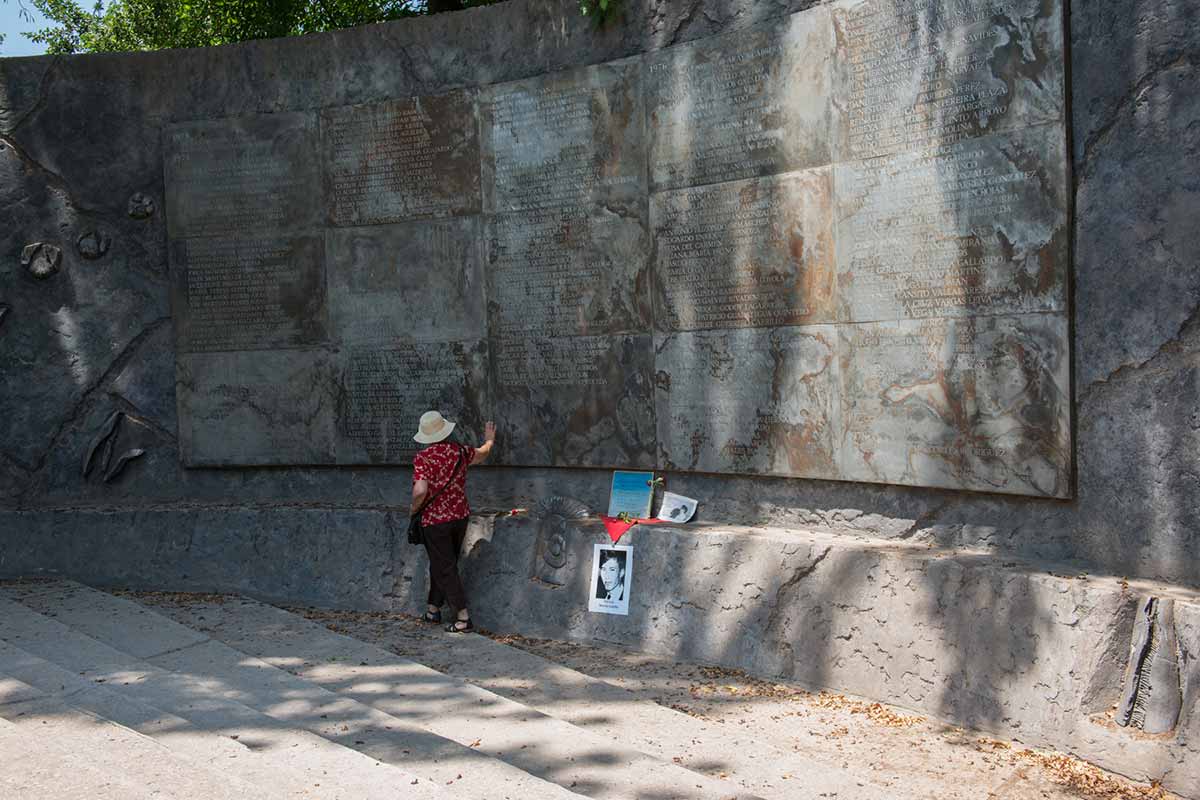In 2013 I once again returned to Villa Grimaldi, this time accompanied by a group of colleagues from the U.S. and Chile who wanted to experience the tour with Pedro Matta. Teresa Anativia, a close friend and a survivor of Villa Grimaldi, accompanied us. She and Pedro knew each other, and the tour this time was less scripted as the two of them recollected incidents that took place in various parts of the site. Teresa could speak far more directly to the things that women had experienced there. She had already told me some of the terrible things that DINA had done to her and her companions in that place. She had also told me about the first time she and other survivors had returned after the space had been reclaimed. They all met—about 150 of them, she recalls, outside the metal gate. Once inside, the Priest José Aldunate—who had also been held captive there—locked the portón shut forever. The survivors hugged and wept in silence. She recalls that everyone shut their eyes as they embraced their fellow survivors—they had never seen each other before; they had never heard each other’s voices: “The silence at a reunion of the blind who had been together and had never seen each other,” as she put it. They started to look around the space, covered with brambles and barbed wire, and recognized nothing. “We looked for those places and we couldn’t find them. I know I will never find them,” she concluded. When we were there, in Villa Grimaldi together, I asked her if it upset her to go back.
“No,” she said, “this is not the place.”
The redesigned space, landscaped gardens, roses, beautiful trees, the water pools and pavilion had nothing to do with the place in which she had been tortured, violated, and denied her humanity.
That “place” remains in her; she carries it with her everywhere. As Charlotte Delbo, the Holocaust survivor, writes in Days of Memory: “I don’t live with Auschwitz, I live next to it” (Delbo 1990, 2).
Click “cc” for English language subtitles
What then, does the renovated Villa Grimaldi do?
At one point, during the early years of the survivors’ struggle to secure the space as a memory site, the place was probably intended, in part, as a place to externalize and put one’s grief. They had lost an enormous amount in that place—a tortured woman lost the twins she was carrying. Teresa and Pedro both admitted to losing not only friends, but part of their own humanity—their ability to trust others. Their bodies changed, and they carry the pains and fractures induced by torture into their older age. The loss and grief that accompany disappearance and torture belong to that realm of invalidated grief. The Mothers of the Plaza de Mayo in Argentina, and the Mothers in Chile, never knew if their children were alive or dead. The government did not acknowledge their loss. How can one grieve under these circumstances?viii
While those killed in Villa Grimaldi are named in the rosters of “Victims” on the current Villa Grimaldi website and carved into the Memory Wall, survivors have no place. The 1991 Rettig Report issued after the Truth and Reconciliation Commission listed only the cases of those disappeared and murdered by the Pinochet regime. The Valech Report, issued by the National Commission on Political Imprisonment and Torture (2004-5) acknowledged those who had been tortured and detained, as well as the children of the disappeared. The Chilean state used that list to make reparations to survivors. But that does not address the phenomenon that Teresa Anativia pointed to with “this is not the place.”

Torture and disappearance continues to affect the victims and their families for generations. Not only does torture stress bodies in ways that can never fully heal, but as Teresa Anativia’s testimony makes clear, it also creates emotional distress that never fully goes away. Tortured people, turned into zombies as Matta says, face the challenge of bringing themselves back to life—often in a political or social climate that denies or invalidates the trauma. Families of these victims often accompany their loved ones in the devastating pain, loss, and reconstitution of the self. Disappearance also terrifies trans-generationally. The parents and grandparents of the disappeared spend their lives trying to find not only the bodies of their loved ones but also the perpetrators who killed them. Where are they? In what place? For the children of the disappeared, the search often continues throughout their entire lives, affecting the lives of their own children. Torture and disappearance target the filiative and affiliative bonds that keep individuals centered and connected. Restitution entails building those bonds again, and connecting individuals back into their circles, and helping them learn to trust again.
Places like Parque de la Paz Villa Grimaldi remind us of what happened within those walls, but they also transcend the violence and pain in search of peace and reconciliation. The park performs a restorative, world-making gesture. But it can never be the place of the terror, the center of unmaking of so many worlds of the people who died in or passed through Terranova. I cannot capture that place with my camera. Matta cannot conjure it for others to see. Teresa Anativia does not recognize it. But being in the park with them, I sense the power of place, I feel the pain they associate with it, and I accompany them for a little while on their very long journey towards acceptance and renewal.